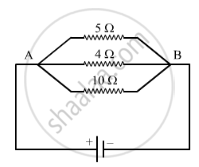Advertisements
Advertisements
प्रश्न
State Ohm’s law.
उत्तर
Ohm’s law states that electric potential difference across two points in an electrical circuit is directly proportional to the current passing through it. That is,
V~I
The proportionality constant is tne resistance (R) offered between the two points.
Hence, Ohm’s law is written as,
V = RI (or) V = IR
Where, V is the potential difference in volt (V), I is the current flow in ampere (A), R is the resistance in ohm (Ω)
APPEARS IN
संबंधित प्रश्न
What is meant by saying that the potential difference between two points is 1 V?
What is a voltmeter?
Name a device which helps to maintain potential difference across a conductor (say, a bulb).
The p.d. across a lamp is 12 V. How many joules of electrical energy are changed into heat and light when: a current of 2 A flows through it for 10 s?
In the circuit diagram given below, the current flowing across 5 ohm resistor is 1 amp. Find the current flowing through the other two resistors.

What current will be taken by a 920 W appliance if the supply voltage is 230 V?
Calculate the potential difference between the two terminals of a battery if 100 joules of work is required to transfer 20 coulombs of charge from one terminal of the battery to the other.
A current of 100 mA. flows through a wire. The charge on an electron is 1.6 × 10-19 C. Find the number of electrons passing per second through the cross-section of the conductor.
100 J of heat is produced each second in a 4 Ω resistor. The potential difference across the resistor will be:
